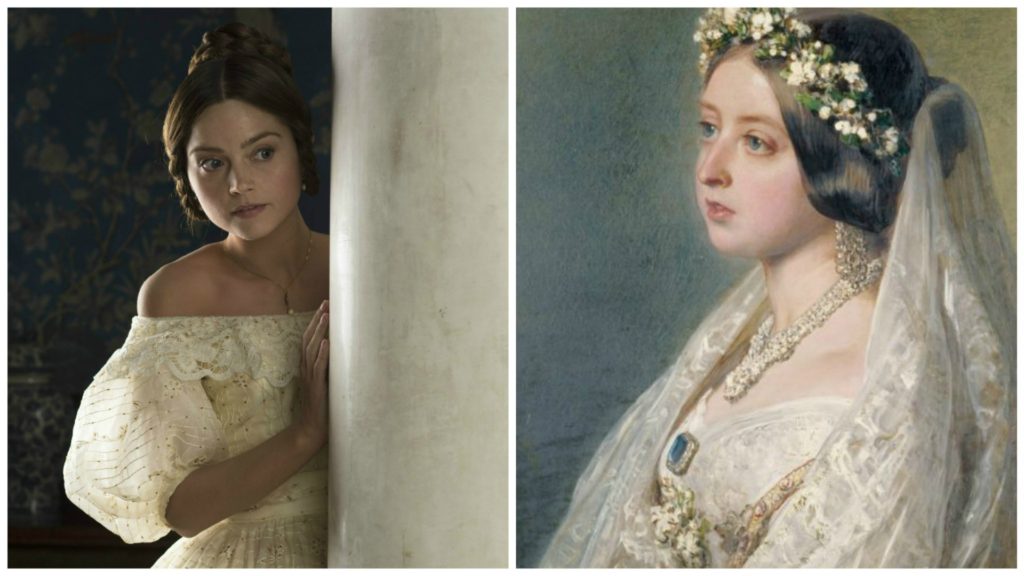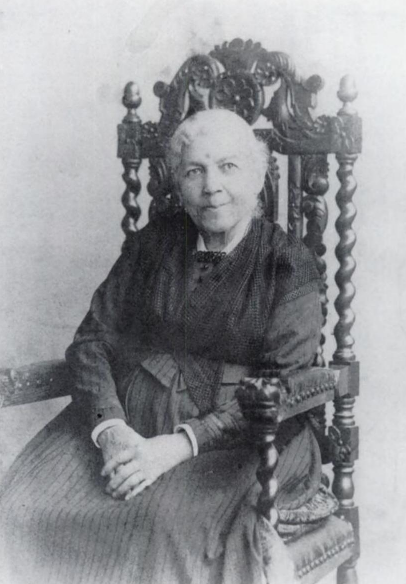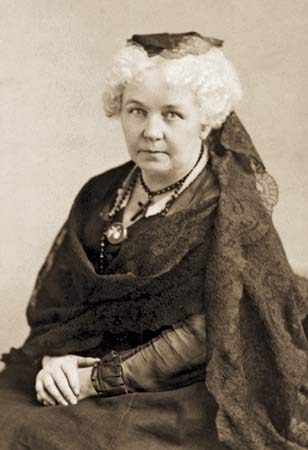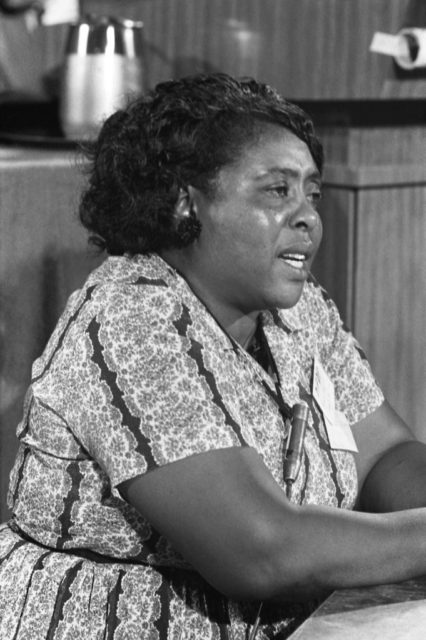
Jenna Coleman as Queen Victoria in PBS’s “Victoria” (left) and the real Queen Victoria in 1847. “Victoria” photo courtesy of ITV plc.
By Katie Moritz
In the news and popular culture, women are taking the spotlight, and the world is taking notice. PBS’s “Victoria,” premiering Jan. 15 on “Masterpiece,” will add to the growing stable of women-led TV series by telling the story of teen Queen Victoria, who ruled the United Kingdom from 1837 to her death in 1901. (Jenna Coleman of “Doctor Who” fame will play the royal, and the series was created by producer Daisy Goodwin.)
So, who was Queen Victoria? At the age of 18, Victoria took up the crown after the death of her uncle, King William IV. The king’s brothers, including Victoria’s father, had died previously, leaving her as the heir apparent. She went on to become one of the most influential people of the 19th century, setting cultural standards that exist to this day (bet you didn’t know she’s the reason behind white wedding dresses). Although she ruled the British empire during a time when monarchs didn’t hold too much actual power, she used her position to influence decisions behind the scenes. Her nine children married nobles and royals all over the European continent, allying the countries and garnering her the nickname “the grandmother of Europe.” (Also, she was the one who proposed to her husband, Albert.) She ruled the U.K. for almost 64 years, the longest of any British monarch until Queen Elizabeth beat her streak in 2015.
Who else defied tradition to change the world as they knew it?
Women’s history scholar Katherine Jellison of Ohio University shared four of her favorite influential figures—a few of which you’ve likely never heard of.
Harriet Jacobs — author and former slave

After surviving sexual abuse at the hands of her white master, Harriet Jacobs (1813-1897) escaped slavery in North Carolina by hiding in a crawl space in her grandmother’s nearby house for seven years. During that time, she watched her children, who were also slaves, grow up in the house by looking at them in secret through a knot in the wooden wall.
“She quite literally keeps an eye on them,” Jellison said.
Even though it was against the law for her to learn how to read and write, Jacobs did anyway. And when she finally escaped to Boston and became a free woman, she wrote her memoir, “Incidents in the Life of a Slave Girl.” But she was surprised and disappointed when she continued to experience racial discrimination in Boston, considered to be the cradle of the Abolitionist Movement.
“There are people (in Boston) who don’t believe the story because they can’t believe that a former slave woman could write such a book,” Jellison said. “So for a long time, people assumed it was a work of fiction.”
It wasn’t until the 1980s that a scholar “was able to document everything that was in the book and prove it was a true story,” she said.
T. Hall — 17th-century gender revolutionary
T. Hall (c. 1603-after 1629) was born Thomasine Hall in England and came to colonial Virginia in the 1620s to work as an indentured servant. T. also went by “Thomas” throughout their life and claimed both male and female genders.
“Before T. came to the Americas, T. traveled through the (European) continent to fight with the military,” Jellison said. “On the passage to Virginia, T. presented as male, but in Virginia there was a really skewed sex ratio—six men to every one woman—so T. found it advantageous to be a woman and call herself by the name she was given at birth because people who knew women’s skills were in great demand in colonial Virginia.”
The only reason historians know about T. is because they eventually got into trouble with the law for their nontraditional gender presentation. They were known to wear both men’s and women’s clothing interchangeably.
“It was a society that couldn’t deal with that kind of ambiguity,” Jellison said. “In the end, the court decided that T. would have their own gender category, they would be both male and female, and they were ordered to dress in trousers but with an apron and a female head covering. … This being a society that always wanted to put you in a category, and you were to dress according to your category, (they decided) ‘You will dress in your own category.’”
T. Hall “is important in that we see the expression of gender identity that today we would, as an umbrella term, call ‘transgender,’” Jellison said. “In reality it’s been around throughout history.”
Elizabeth Cady Stanton — the “idea woman” behind the original women’s movement

Susan B. Anthony gets a lot of credit for the 19th-century women’s movement (you know, the one that eventually got women the right to vote). She’s on a coin, after all. But Elizabeth Cady Stanton (1815-1902) was the brains behind a lot of the strategy publicly spearheaded by Anthony.
Stanton “comes up wth the founding document of the women’s movement, the Declaration of Sentiments, which calls for women to have the right to vote,” Jellison said.
Actually, Anthony wasn’t at that first meeting where the document was signed. (Her father was, though.)
Susan B. “eventually joins and becomes the public spokesperson (of the movement) because she was a single woman and doesn’t have the domestic responsibilities that Elizabeth Cady Stanton has,” Jellison said.
Stanton balanced her life as a wife and mother with behind-the-scenes work on women’s rights. She wrote many of the famous speeches delivered by Anthony.
“I call her the intellectual guiding force behind the movement,” Jellison said. “Most of the ideas evolved from her mind and pen.”
Fannie Lou Hamer — a public face of the 1960s black, rural South

Fannie Lou Hamer grew up in a poor sharecropping family in Mississippi without knowing what civil rights were, let alone that she had them. In the summer of 1964, activists traveled around rural Mississippi educating people there on their rights. Hamer was one of the residents they reached.
“She’s inspired by this,” Jellison said. “She’s (then) trying to get black people in rural Mississippi to register to vote, and she is quite abused—she’s arrested, she’s taken to jail, she’s beaten for doing this. … She has very humble origins and she becomes a TV star briefly in 1964 at the Democratic National Convention that year.”
Hamer traveled to the DNC as the co-chair of the Mississippi Freedom Democratic Party, a racially integrated group formed to oppose the “Mississippi Regulars,” the all-white Democratic delegation representing the state at the convention.
“People involved in the Civil Rights Movement said, ‘That doesn’t represent Mississippi,… we’re the ones that represent Mississippi,’” Jellison said.
Hamer lit up television screens across the U.S. as she testified to convention officials about why her group should be chosen to represent the state over the Regulars. It was then that she made her famous quote: “If the Freedom Democratic Party is not seated now, I question America. Is this America, the land of the free and the home of the brave…?”
Ultimately, the convention offered the Freedom Democratic Party two of Mississippi’s seats. Hamer rejected them.
“We didn’t come all the way up here to compromise for no more than we’d gotten here,” she said. “We didn’t come all this way for no two seats when all of us is tired.”
“The national television audience said, ‘Hey, this is a side of Mississippi life we don’t hear about,’” Jellison said. “Here’s someone from the humblest of origins who captures national attention and… brings so much of the nation to a new understanding and sympathy of the Civil Rights Movement.”
In 1968, the MFDP was seated at the Democratic National Convention. In 1972, Hamer was elected as a national party delegate.
Victoria on Masterpiece premiered on Jan. 15. All seven episodes of the series are now available to stream online for TPT Passport members.
![]() This article originally appeared on Rewire
This article originally appeared on Rewire
© Twin Cities Public Television - 2017. All rights reserved.
Read Next



